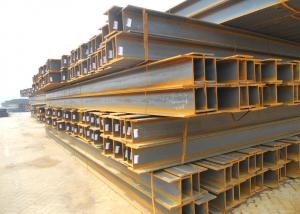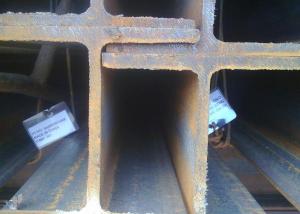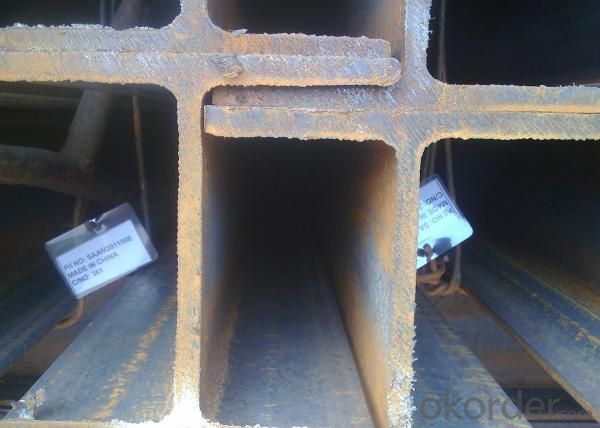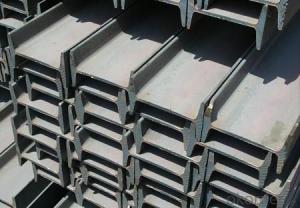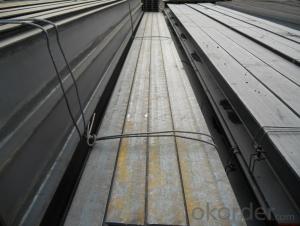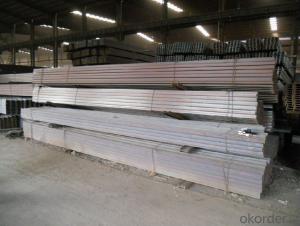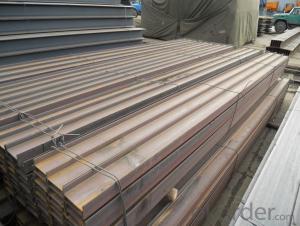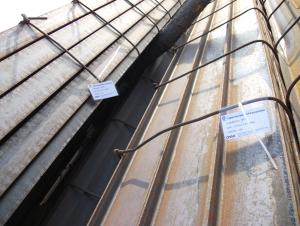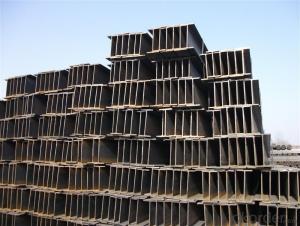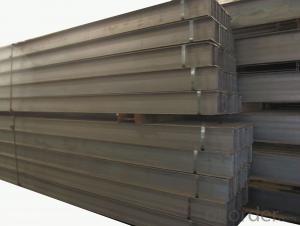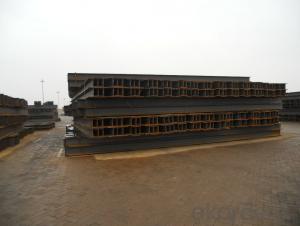Hot Rolled Steel Welded H Beam
- Loading Port:
- China Main Port
- Payment Terms:
- TT or LC
- Min Order Qty:
- 100MT m.t.
- Supply Capability:
- 10000MT m.t./month
OKorder Service Pledge
OKorder Financial Service
You Might Also Like
Specifications of Hot Rolled Steel Welded H Beam
1. Standard: JIS 3192
2. Grade: SS400 or Equivalent
3. Length: 10m, 12m as following table
4. Invoicing on theoretical weight or actual weight as customer request
5.Payment: TT or L/C
6. Sizes:
H x B
(mm)
| T1 | T2 | JIS Weight
(kg/m)
| GB Weight
(kg/m)
|
100*100 | 6 | 8 | 16.9 | 17.2 |
125*125 | 6.5 | 9 | 23.6 | 23.8 |
150*75 | 5 | 7 | 14 | 14.3 |
148*100 | 6 | 9 | 20.7 | 21.4 |
150*150 | 7 | 10 | 31.1 | 31.9 |
175*90 | 5 | 8 | 18 | 18.2 |
175*175 | 7.5 | 11 | 40.4 | 40.4 |
198*99 | 4.5 | 7 | 17.8 | 18.5 |
200*100 | 5.5 | 8 | 20.9 | 21.7 |
194*150 | 6 | 9 | 29.9 | 31.2 |
200*200 | 8 | 12 | 49.9 | 50.5 |
248*124 | 5 | 8 | 25.1 | 25.8 |
250*125 | 6 | 9 | 29 | 29.7 |
244*175 | 7 | 11 | 43.6 | 44.1 |
250*250 | 9 | 14 | 71.8 | 72.4 |
298*149 | 5.5 | 8 | 32 | 32.6 |
298*201 | 9 | 14 | 65.4 |
|
300*150 | 6.5 | 9 | 36.7 | 37.3 |
294*200 | 8 | 12 | 55.8 | 57.3 |
300*300 | 10 | 15 | 93 | 94.5 |
346*174 | 6 | 9 | 41.2 | 41.8 |
350*175 | 7 | 11 | 49.4 | 50 |
340*250 | 9 | 14 | 78.1 | 79.7 |
350*350 | 12 | 19 | 135 | 137 |
400*200 | 8 | 13 | 65.4 | 66 |
390*300 | 10 | 16 | 105 | 107 |
400*400 | 13 | 21 | 172 | 172 |
446*199 | 8 | 12 | 65.1 | 66.7 |
450*200 | 9 | 14 | 77.9 | 79.5 |
440*300 | 11 | 18 | 121 | 124 |
496*199 | 9 | 14 | 77.9 | 79.5 |
500*200 | 10 | 16 | 88.2 | 89.6 |
488*300 | 11 | 18 | 125 | 129 |
596*199 | 10 | 15 | 92.5 | 95.1 |
600*200 | 11 | 17 | 103.4 | 106 |
588*300 | 12 | 20 | 147 | 151 |
700*300 | 13 | 24 | 182 | 185 |
800*300 | 14 | 26 | 207 | 210 |
900*300 | 16 | 28 | 240.1 | 243 |
Usage & Applications of Hot Rolled Steel Welded H Beam
Commercial building structure ;Pre-engineered buildings; Machinery support structure; Prefabricated structure; Medium scale bridges; Ship-building structure.etc.
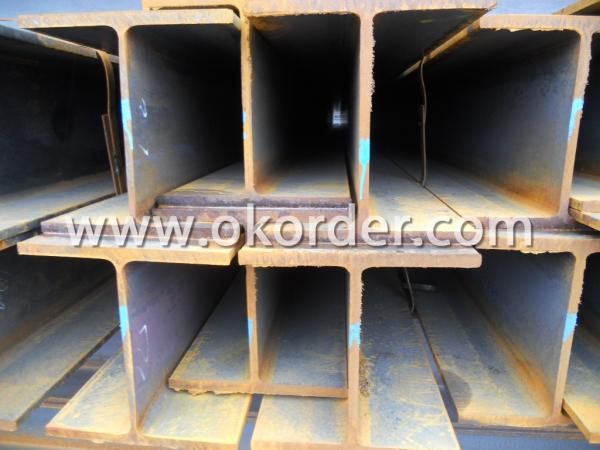

Packaging & Delivery of Hot Rolled Steel Welded H Beam
1. Packing: it is nude packed in bundles by steel wire rod
2. Bundle weight: not more than 3.5MT for bulk vessel; less than 3 MT for container load
3. Marks:
Color marking: There will be color marking on both end of the bundle for the cargo delivered by bulk vessel. That makes it easily to distinguish at the destination port.
Tag mark: there will be tag mark tied up on the bundles. The information usually including supplier logo and name, product name, made in China, shipping marks and other information request by the customer.
If loading by container the marking is not needed, but we will prepare it as customer request.
4. Transportation: the goods are delivered by truck from mill to loading port, the maximum quantity can be loaded is around 40MTs by each truck. If the order quantity cannot reach the full truck loaded, the transportation cost per ton will be little higher than full load.
5. Delivered by container or bulk vessel
Production flow of Hot Rolled Steel Welded H Beam
Material prepare (billet) —heat up—rough rolling—precision rolling—cooling—packing—storage and transportation
- Q: How do steel H-beams compare to wooden beams in terms of cost and performance?
- Steel H-beams and wooden beams differ significantly in terms of cost and performance. In terms of cost, steel H-beams tend to be more expensive than wooden beams. The cost of steel is generally higher than wood, and the fabrication and installation of steel H-beams can also be more labor-intensive and time-consuming. Additionally, steel H-beams often require specialized equipment and expertise, further adding to the overall cost. However, when it comes to performance, steel H-beams have several advantages over wooden beams. Firstly, steel is much stronger and more durable than wood. Steel H-beams can withstand higher loads and have a higher resistance to bending and warping, making them ideal for supporting heavy structures or spanning long distances. Wooden beams, on the other hand, may require additional supports or reinforcement to achieve similar load-bearing capacities. Moreover, steel H-beams are fire-resistant, unlike wooden beams which are highly flammable. This fire-resistant property makes steel H-beams a safer option for construction in areas prone to fire hazards. Additionally, steel H-beams are less prone to insect infestations, rot, and decay, which are common issues with wooden beams. This durability translates into a longer lifespan and reduced maintenance costs for structures built with steel H-beams. In conclusion, while steel H-beams tend to be more expensive than wooden beams, they offer superior performance in terms of strength, durability, fire resistance, and low maintenance. Therefore, the choice between steel H-beams and wooden beams ultimately depends on the specific requirements of the project, budget constraints, and the desired lifespan of the structure.
- Q: How do steel H-beams contribute to the overall stability of a building?
- Steel H-beams contribute to the overall stability of a building by providing structural support and load-bearing capacity. The H-shape design allows for even distribution of weight and enables the beam to efficiently bear heavy loads. Additionally, the rigid nature of steel helps to resist bending, twisting, and deformation, thereby enhancing the structural integrity of the building.
- Q: Can steel H-beams be used in educational institutions and schools?
- Yes, steel H-beams can be used in educational institutions and schools. Steel H-beams are commonly used in construction for their strength, durability, and load-bearing capabilities. They are often used in the construction of bridges, high-rise buildings, and other large structures. In educational institutions and schools, steel H-beams can be used for various purposes such as supporting the framework of buildings, constructing gymnasiums and auditoriums, creating outdoor structures like canopies or walkways, and even for educational purposes in engineering or construction-related courses. The use of steel H-beams in educational institutions ensures the safety and stability of the structures, providing a conducive environment for learning and activities.
- Q: Can steel H-beams be used in industrial manufacturing facilities?
- Yes, steel H-beams are commonly used in industrial manufacturing facilities due to their high strength and load-bearing capacity. They are often used as structural support beams, providing stability and durability to the facility's infrastructure.
- Q: How do you calculate the section modulus of steel H-beams?
- To calculate the section modulus of steel H-beams, you need to know the moment of inertia of the beam's cross-sectional shape. The section modulus is a geometric property that measures the beam's resistance to bending. It is calculated by dividing the moment of inertia by the distance from the neutral axis to the furthest point on the beam's cross-section. Here are the steps to calculate the section modulus of steel H-beams: 1. Determine the moment of inertia (I): The moment of inertia is a measure of how the area of the cross-section is distributed around the neutral axis. It can be calculated using standard formulas or obtained from engineering tables specific to H-beams. The moment of inertia will vary depending on the size and shape of the H-beam. 2. Find the distance to the furthest point (c): Measure the distance from the neutral axis to the furthest point on the cross-section. This distance is usually half the height of the H-beam. 3. Calculate the section modulus (Z): Divide the moment of inertia (I) by the distance to the furthest point (c). The resulting value is the section modulus. Section Modulus (Z) = Moment of Inertia (I) / Distance to furthest point (c) The section modulus is usually expressed in cubic inches or cubic millimeters, depending on the unit system being used. It represents the beam's resistance to bending and can be used to determine the beam's strength and deflection under different loading conditions. It's important to note that the section modulus is a property specific to the cross-sectional shape of the beam and is used in structural engineering calculations to design and analyze steel H-beams for various applications.
- Q: What are the different types of connections used for steel H-beams?
- There are several different types of connections used for steel H-beams, depending on the specific application and the load requirements. 1. Welded Connections: Welding is a common method used to connect steel H-beams. It involves melting the steel at the joint and fusing it together. Welded connections offer high strength and rigidity, making them suitable for heavy loads and structural applications. 2. Bolted Connections: Bolted connections involve using bolts and nuts to secure the H-beams together. This type of connection offers flexibility as it allows for disassembly and reassembly if needed. It is commonly used in situations where ease of installation and maintenance are important. 3. Riveted Connections: Riveting is an older method of joining steel H-beams, but it can still be found in some older structures. It involves using rivets, which are metal pins that are inserted through pre-drilled holes and then hammered or compressed to create a permanent connection. 4. Moment Connections: Moment connections are used when there is a need to transfer significant bending moments between the H-beams. These connections provide enhanced rigidity and stability by resisting rotational forces. They are commonly used in building frames and structures that experience heavy loads or seismic activity. 5. Shear Connections: Shear connections are designed to transfer shear forces between the H-beams. These connections typically involve welding or bolting steel plates or angles to the webs and flanges of the H-beams to enhance load-bearing capabilities. 6. Pinned Connections: Pinned connections allow for rotation at the joint and are commonly used in situations where flexibility and movement are required. These connections typically involve using pins or bolts to connect the H-beams, allowing them to pivot or rotate. It is important to note that the choice of connection type depends on factors such as the load requirements, structural design, and specific application. Consulting with a structural engineer or following relevant building codes and standards is crucial to determine the most appropriate connection type for steel H-beams in a given scenario.
- Q: Can steel H-beams be used in the construction of telecommunications infrastructure?
- Yes, steel H-beams can be used in the construction of telecommunications infrastructure. H-beams are commonly used in construction due to their high strength-to-weight ratio, which makes them an ideal choice for supporting heavy loads. They provide excellent structural integrity and stability, making them suitable for various applications, including telecommunications towers, antennas, and equipment shelters. Steel H-beams can withstand extreme weather conditions and provide the necessary support for the installation and maintenance of telecommunications equipment. Additionally, they can be easily fabricated and assembled, allowing for efficient construction and flexibility in design. Overall, steel H-beams are a reliable and durable option for constructing telecommunications infrastructure.
- Q: Are steel H-beams suitable for solar panel mounting structures?
- Yes, steel H-beams are suitable for solar panel mounting structures. They offer excellent strength and durability, making them an ideal choice for supporting the weight of solar panels. Additionally, steel H-beams can withstand various weather conditions, providing stability and longevity to the solar panel installation.
- Q: What are the different types of steel used for manufacturing H-beams?
- When manufacturing H-beams, various factors need to be considered in order to select the appropriate type of steel. These factors include the required strength, durability, and cost-effectiveness for the specific application. 1. The most commonly used type of steel in H-beam manufacturing is carbon steel. It consists primarily of iron and carbon, with small amounts of other elements. Carbon steel is well-known for its affordability and high strength, making it a popular choice for a wide range of applications. 2. Another type of steel used for H-beams is alloy steel. This type of steel contains additional alloying elements such as chromium, nickel, or molybdenum. These elements enhance the steel's strength, hardness, and resistance to corrosion. Alloy steel H-beams are often used in heavy-duty construction projects or applications that require exceptional strength. 3. Stainless steel is a type of steel that contains a minimum of 10.5% chromium. This gives it excellent resistance to corrosion and staining. H-beams made from stainless steel are commonly used in applications where hygiene, durability, and aesthetic appeal are critical, such as in the food industry or architectural structures. 4. High-strength Low-alloy (HSLA) steel is another type of steel used for H-beams. It provides high strength and improved toughness compared to standard carbon steel. HSLA steel often contains small amounts of alloying elements such as vanadium, niobium, or titanium, which enhance its mechanical properties. HSLA steel H-beams are commonly used in applications that require a high strength-to-weight ratio, such as bridges or heavy machinery. 5. Weathering steel, also known as Corten steel, is a type of steel that develops a protective layer of rust when exposed to the elements. This layer acts as a barrier against further corrosion and eliminates the need for painting or maintenance. Weathering steel H-beams are often utilized in outdoor structures like bridges or sculptures. Considering factors such as strength, durability, corrosion resistance, and cost-effectiveness, it is crucial to select the appropriate type of steel for manufacturing H-beams based on the specific requirements of the project.
- Q: Can steel H-beams be used in commercial building facades?
- Yes, steel H-beams can be used in commercial building facades. These beams offer structural support and can be aesthetically pleasing when incorporated into the design. They provide durability, strength, and flexibility, making them suitable for commercial applications where large spans and vertical loads need to be supported.
1. Manufacturer Overview
| Location | Tangshan, China |
| Year Established | 2007 |
| Annual Output Value | Above US$ 80 Million |
| Main Markets | Mid East; Southeast aisa; korea |
| Company Certifications |
2. Manufacturer Certificates
| a) Certification Name | |
| Range | |
| Reference | |
| Validity Period |
3. Manufacturer Capability
| a) Trade Capacity | |
| Nearest Port | Tianjin; |
| Export Percentage | 20% - 25% |
| No.of Employees in Trade Department | 11-15 People |
| Language Spoken: | English; Chinese |
| b) Factory Information | |
| Factory Size: | Above 75,000 square meters |
| No. of Production Lines | 1 |
| Contract Manufacturing | OEM Service Offered; |
| Product Price Range | Average |
Send your message to us
Hot Rolled Steel Welded H Beam
- Loading Port:
- China Main Port
- Payment Terms:
- TT or LC
- Min Order Qty:
- 100MT m.t.
- Supply Capability:
- 10000MT m.t./month
OKorder Service Pledge
OKorder Financial Service
Similar products
Hot products
Hot Searches
Related keywords

